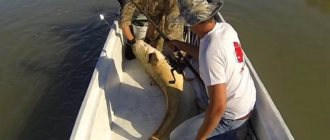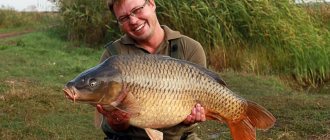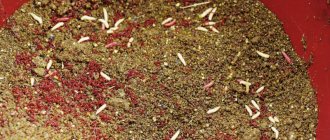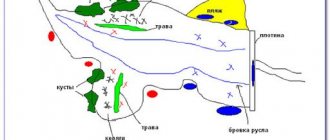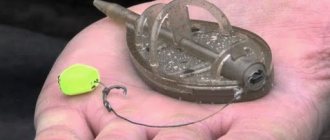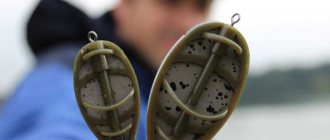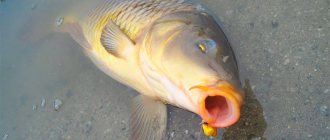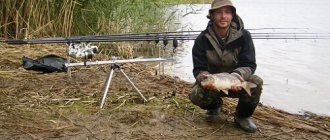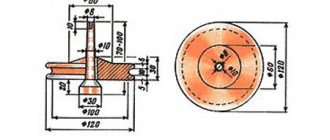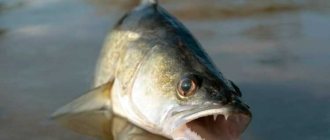Yuri 09/07/2020 1212
Every fisherman knows that the balalaika is an original Russian musical instrument. But not everyone can answer what a balabaika is. Balabaika or otherwise putavusha is a very effective, simple tackle for catching carp from a boat. Previously, it was used for catching exclusively predatory fish, but over time it was tested by carp anglers, who began to use this method of fishing everywhere.
Despite the crude manufacturing, the tackle works equally well in deep reservoirs and on rivers with weak and medium flows. Catching carp with baits is similar to catching pike or pike perch with mugs, but differs in tactics and installation of gear.
Fishing place
It’s better to look for carp around:
- River pits.
- Deep places.
- Places with snags.
- Steep banks with washouts.
- Places of the edge of river algae.
- Small river bays.
- Habitats of zebra mussel mollusks.
- Thickets of reeds, water lilies, arrowheads and other aquatic plants.
- Places with sharp changes in depth.
When is the best time to catch:
- Time of year - the period from the end of June to the end of August, because... Carp spawns in early July at an average air temperature of + 18 degrees.
- At this time, it is better to catch carp with a bottom or float rod using worms with bait in the form of porridge.
- In the cold season - at the end of November and in winter, carp are not caught.
- The depth of the pits in which carp can most often be found should reach 2-3 meters.
Equipment for catching carp
It will be sad and disappointing if a good fish covets the bait, but you can’t get it into the landing net because the rod is too hard or the fishing line is unreliable. Float rods are:
- match;
- plug-in;
- Bolognese;
- flywheels.
Any of the listed rods is suitable as a fishing rod for catching carp in currents or still water, but each of them has its own characteristics
At the same time, there are unifying characteristics and among them we pay attention to:
- system;
- test;
- material of manufacture;
- length;
- price.
Carp are caught on all types of float rods, and the specific choice depends on the fishing conditions.
Flying rods
Fly rod blanks do not have guide rings, and a rubber shock absorber on the tip is used to secure the equipment.
In preparation for fishing for carp, the angler knits several rigs that differ in length and weight, so that while fishing he can quickly change equipment when fishing conditions change. It is inconvenient to knit rigs on a pond, because it will require you to be distracted from your favorite activity, so you need to prepare in advance. Flying rods are:
- telescopic;
- plug-in
Telescopic rods are more convenient for transportation, but create difficulties when preparing for fishing and changing rigs. The length of a telescopic float rod rarely exceeds 7 meters.
Plug-in fly blanks are mounted from several bends inserted into one another and this is more convenient, because in order to shorten the length of the blank it is enough to remove the lower bend. Plug fly rods exceed 7 meters in length, and the fisherman himself selects the required length for the conditions in which fishing takes place.
Plug-in float rods
Plug rods also do not have rings, but their design involves the presence of a rubber shock absorber located inside the upper knee. The plastic connector to which the equipment is attached is located on the tip and the plug rubber absorbs jerks of the fish when fishing.
For fishing with a plug on a float, a retractable roller is used, along which the form “rolls back” when fishing, which makes it possible to remove the lower legs. After removing the extra legs, fishing is done as with a short fly rod, and the fish is brought into the landing net.
Bologna rod
This is the simplest and most common float rod, equipped with rings, but it is used to catch small fish at a short distance. The length of the “lapdog” is from four meters or more and it is equipped with small inertia-free reels that simplify the work with the equipment.
Match rod
Match blanks are equipped with guide rings and are used for long-distance fishing with sliding equipment. Such rods have a reel mount, which makes it convenient to fish at a distance of 10 meters or more. The main feature of the “match” is the presence of a sliding float, because it is difficult to accurately set the diving depth over a long distance.
Carp are caught on all types of float rods, taking into account the choice of location, as well as the weight and activity of the fish, but match and plug rods are used most often. The Bolognese fishing rod is too “flimsy” and rough, and the fly rod is not very convenient to handle, especially in those places where you have to catch carp. These are not paid reservoirs, where places for anglers are equipped according to all the rules of comfort, so this factor plays a big role when choosing the type of float rod.
In addition, the match and the plug help to successfully fight and defeat wild carp without breaking the fragile form as a result of careless movement. The fisherman does not know in advance what size fish will be hooked, so he must be prepared for any surprises. A match rod is also convenient in that it is equipped with an inertia-free reel and using its capabilities, in particular the operation of a friction clutch, it is much easier to tire out a trophy fish and bring it into the landing net.
Important! Catching carp is a low-active type of fishing and it is inconvenient for the fisherman to hold the rod in his hands all the time, so in this regard, a plug and match rod is the best choice.
Times of Day
Early morning at dawn, especially in depressions without current and in thickets of aquatic plants. At dawn, it is more profitable to catch carp in the area of deep-water holes, in the evening and at night - in shallow water.
What you should consider when going for carp:
- Young individuals live in flocks, while adults and large ones live alone.
- This fish spawns in May and July, laying eggs on last year's vegetation.
- The carp does not come close to the shore, choosing deep-water places.
- Night is the time of active movement of carp in search of food.
- The main natural food of fish are mollusks, worms, larvae of various insects, and in rare cases even small fry.
- In winter, the carp does not particularly need food and lies in schools at the bottom.
Bait and location selection
Boilies must have a pleasant smell that attracts carp. This fish responds well to sweet smells, as well as garlic and anise.
Carp is a wild fish, so bait should be selected in accordance with its taste preferences. For him, the best food is considered to be that which he receives in natural conditions. To prevent the bait from falling out of the feeder, it must be dense.
Clay can be used for a bonding effect.
Which baits to give preference to so that the trophy does not pass by the baited place:
- An effective and proven type of bait are boilies. These are ordinary small balls from 1.5 to 3 cm in diameter. They may contain various products.
- Animal baits such as worms, bloodworms, maggots.
- Any cereals , white bread, boiled potatoes, dough.
The carp almost never stands still . He is always in search of food, so determining his location is quite problematic. It is better to look for fish in quiet places, far from areas of constant recreation of people. Large individuals often live where the topography of the reservoir is pitty. In addition, carp does not like strong currents, so it prefers places with slow currents.
In summer, on hot days, it can be found at a depth of about 2 meters near the reeds. Thus, he hides from the sun. It is recommended to feed in several places at the same time and fish with a feeder from the shore. As evening approaches, the fish can afford to go out into shallow water.
In cloudy, cool weather, the carp goes deeper, so it is better to catch it from a boat.
Basic requirements for fishing gear for carp
- Since carp is a large and strong fish, the tackle must be powerful enough to withstand a certain load.
- For the same reason, the fishing line must be very strong.
- It would also be useful to have a powerful reel to hook the fish in time. In any case, the tackle must be “running”.
- The feeder must be heavy so that it is not carried away by the current and the calm carp has time to enjoy the delicacy.
Carp can be caught using different gear:
- Float rod.
- Feeder.
- Donka.
- Makushatnik.
- Rubber.
- Winter fishing rod.
Carp fishing gear
Let's start with the rod. There is no significant difference in how long it will be. Some people prefer a two-meter fishing rod, while others fish with a two-piece fishing rod longer than three and a half meters. Among the fans of the spring there are many fishermen who calmly fish with the cheapest Chinese “telescope”. And it’s not a fact that some mega-expensive fishing rod for carp will be more effective in each specific case.
The test of such a fishing rod should be at least forty grams. More precisely, it is necessary that the feeder with bait weigh no more than what is stated by the manufacturer of the rod. Of course, in Chinese cheap fishing rods the stated test rarely corresponds to reality. The second thing you need is a good coil for a hundred meters with a diameter of up to 0.3 mm. Ideally, the clutch should be rear. However, many people prefer to take reels with a baitrunner. But this is not some kind of mandatory item, but protection against loss of gear during strong jerks.
Read: How to properly feed carp?
The weight of the feeder depends on how silted the reservoir is and on the casting distance. If you fish in a silty area, then 20 grams will be enough. Long casting requires heavier options. An 80-gram feeder is already suitable here. If the weight of the feeder is large and you do not want to take risks, then use a shock leader to protect against breakage. Anglers often make mistakes in choosing the length of the shock leader. Remember once and for all - the optimal length is twice the length of the rod.
Choosing a float rod for fishing.
The length of the rod depends on the distance over which you expect to cast the tackle. The average length is 5 meters. If the rod is longer, it will automatically become heavier, which will complicate the process of casting a float rod.
Particular attention must be paid to the tip of the rod: it should be as sensitive as possible in order to hook the fish as softly as possible. Otherwise, any fish may fall off the hook or become deformed
It is recommended to choose rods from lightweight materials
- Coil. Most often, fishermen use an inertia-free reel to catch carp. Even a novice fisherman can handle it. And the ability to cast a light bait over a long distance, a wide range of reeling speeds and the presence of a friction brake will ensure fishing success in the most unforeseen situations.
- Fishing line. The fishing line for carp should be as strong as possible. It is better to use a fishing line with a diameter of 0.6 to 1 millimeter. Since monolithic fishing line stretches better, it is most suitable for catching large and strong carp.
- Hooks. Hook sizes may vary depending on the size of the intended prey. But hook numbers from 5 to 7 are quite suitable for catching fairly large specimens.
- Float. There is no way to do without a float, because this is the main bite signal. Under no circumstances should carp notice the bright color of the float, therefore, the more inconspicuous the color, the better. The float must be sliding, because the carp is a strong and dynamic fish. You also need to pay attention to the weight of the float. To catch carp, it is better to choose a goose feather float, which is attached to the fishing line in two places.
- Sinker. There must be several sinkers and their weight must vary. The weight of the sinkers decreases as they are positioned from line to hook, and the lightest and smallest last sinker should be located at a distance of about 10 centimeters from the previous (penultimate) weight. Compliance with these rules will ensure ease and correctness when casting and in the process of catching fish. The sinker should slide through the water without providing resistance to the carp when biting:
- If you still decide to catch carp in a strong current, then you need to take a fairly heavy sinker - up to 200 grams.
- If during a test cast the float goes under water, then the sinker is too heavy for this tackle. And if the float lies on the water or stands sideways, then it is worth adding the weight of the sinker.
Advantages of a float rod:
- Lightness of design.
- It is a universal tackle regardless of the choice of fishing location and intended catch.
- “Blind” equipment allows you to fish in thickets of aquatic plants, where carp often live.
- The structure of the float rod allows you to quickly replace any component parts of the equipment yourself, if necessary.
Disadvantages of a float rod:
- The line in such a fishing rod does not run along the rings, which can lead to the line often getting tangled.
- Throwing the tackle is only possible over a limited distance, which each time depends on the specific fishing location.
- The impossibility of fishing at sufficiently large depths and in strong currents.
- If a float rod does not have rings and a reel, it will not be suitable for fishing from steep and steep banks.
Necessary gear
To catch carp, use fishing rods or bottom gear.
The rods are well suited for fishing in calm water, from a boat or from the shore. But for fishing in the current, bottom gear specially designed for this purpose, such as a feeder, is more often used. The length of the feeder determines the casting distance, the most optimal is 3.3-3.9 m, but for ultra-long casts and in strong currents you can use rods up to 5 m. The rigidity should be medium, and it is desirable that the rod has a well-bending end, this will make it easier to land fish.
The thickness and quality of the fishing line play an important role. It is better to use monofilament, because braided fishing line breaks more often when caught on stones and snags. Its thickness should not be too large, because a cautious carp may notice it and not approach. The optimal option is 0.3-0.4 mm, but some fishermen choose even a smaller thickness, up to 0.2 mm, to reduce water resistance and reduce the drift of the feeder by the current.
However, this thickness may not be enough to fish out a large carp. In addition, you should pay attention to the color of the fishing line: it can be matched to the tone of the water, as well as line coloring for better camouflage.
The main components of the gear are:
- rod;
- main line;
- leash;
- hook;
- feeder;
- swivels;
Their final collection occurs directly at the fishing site. In this case, a feeder of the required weight is selected, usually 80-120 g, depending on the type of equipment and current. If necessary (strong current), additional weight is added to the feeder. A leash with a hook is attached to the equipment and together with it is attached to the main fishing line.
How to fish and what to consider when fishing with a float rod:
- Fishing conditions:
- Depth should not exceed 2–3 meters.
- The distance from the shore is up to 15 meters.
- Current speed - it is better to choose places with weak currents (small bays, oxbow lakes, stakes, whirlpools), otherwise the tackle will be carried away
- Wind speed - when the wind is strong, it is better to fish in a place where there is a headwind, attach an elongated float with two attachment points, and feed the fish a meter closer than usual.
- The bait should have a viscous structure and not break up into small pieces, otherwise it will attract too small fish. Stronger current means more bait.
- Fishing technique:
- Casting is best done using the “pendulum” type, releasing the nozzle while simultaneously moving the rod up and forward.
- The angle of the rod with the line from the float should be straight.
- It's better to catch while standing.
- The fisherman needs to constantly monitor the line release. On the one hand, the fishing line should not be tensioned loosely, on the other hand, it should not rise very high. This can be done by holding the line with your finger or using a reel.
- During the fishing process, make sure that the line is not pulled too tightly, because if the fish is not firmly hooked on the hook, it may break off. To do this, you need to raise the end of the rod, position it at an angle of 80 degrees to the surface of the water and be sure to have a good supply of fishing line.
- When biting, the hook must be done at the moment when the fishing line is well stretched between the tip of the rod and the float.
How to catch carp on a stand
The process of catching carp with a balabaika begins with the angler loading the necessary gear and groundbait with bait into the boat, and begins searching for carp sites. To find a place to feed, you must remember that carp is a sedentary fish, which does not change its permanent habitat unless absolutely necessary.
Carp loves wild, secluded places, snags and depths. On the river, you should look for it where the current slows down, near washed-out steep and steep banks. He also loves areas with sloughs and holes on river bends.
In the summer heat, carp can be found near the border of reeds and among thickets of aquatic plants. In such places it can stay during the day, at a depth of 3 meters or more. Towards evening, when the heat subsides, “wild” carp come out to the shallows. Where you definitely shouldn’t look for carp is near beaches and other places for active recreation of people.
- This is interesting! The easiest and most efficient way to find carp sites is to arrive at the river before dawn. As a rule, at dawn the carp plays, that is, splashes. Mikhail Sholokhov also described this marvelous action in his famous novel “Quiet Don”.
So, having chosen a place and anchored, the fisherman baits the bait hooks, sets the depth, fixing the fishing line between the plate and the buoy, and lowers the tackle into the water.
It’s not difficult to notice a bite on the bait; after sitting on the hook, the carp begins to pull the tackle. Having caught up with the buoy, you need to slowly start landing the fish, pulling it towards the boat. Near the boat itself, the fish must be carefully placed in a landing net and pulled out of the water. By this point, the carp most often no longer offers strong resistance.
In conclusion, I would like to remind you about safety measures when fishing from inflatable floating devices. While in a rubber boat, special care should be taken when landing fish and manipulating tackle. Carp hooks are not among the smallest, and it’s easy to pierce PVC material or rubber with them.
TAGS:
Other gear that can be used when fishing for carp
Spinning
A shortened tackle with a reel used to catch a predator.
Advantages:
- Possibility of casting bait over a fairly long distance
- Carp responds well to the constant movement of the spinning rod, which means that the chances of a good catch when using this rod increase.
It is better to catch carp with a spinning rod in late autumn and early winter, with the onset of cold weather.
The place for fishing at this time is small natural reservoirs in which the water does not freeze. There is very little algae at this time, so the desired fish bites perfectly on artificial bait.
Disadvantages: complex and heavy design of the spinning rod.
Spinning requirements:
- The fishing line needs to be strong and long enough - up to 200 meters.
- A strong rod should have a thin, bright tip to signal a bite.
- The feeder should be quite heavy - up to 100 grams, preferably rectangular in shape, in order to firmly anchor itself to the bottom of the reservoir. For the same purpose, you can attach several pieces of wire up to 10 centimeters long to the feeder.
- A powerful inertia-free reel will provide casting range and clear line fixation at any time.
Winter fishing rod
Recognizable even by people far from fishing, reduced in size compared to conventional float tackle.
Winter fishing rod parts:
- Short, durable rod.
- Sensitive nod.
- Fishing line.
- Bait.
- Coil.
In summer you can use this rod to fish from a boat. Since the depth of the reservoir can be different, the fishing line must be taken with a reserve length.
Requirements for a winter fishing rod:
- The rod, despite its short length, must combine qualities such as strength and flexibility.
- It is advisable to use transparent or multi-colored fishing line for better camouflage.
- The length of the fishing line is 10 – 20 meters.
- Hooks for catching carp should be sharp and large enough - No. 5–7.
- The stronger the current, the larger the float and the heavier the sinker. It should submerge the float a few centimeters.
Rubber
It is very reminiscent of a donka, but between the sinker and the fishing line it contains an elastic band (Hungarian), which returns the fishing line to its place after each bite. The elastic band is very convenient and unpretentious to use, as it allows you to fish at any depth. Such tackle, as well as other rods for catching carp, require strong fishing line, sharp hooks and a fairly heavy weight.
An elastic band will be an indispensable tackle where it is inconvenient to fish with a fishing rod: under overhanging trees, places with snags or overgrown vegetation.
Requirements for the equipment of the elastic band:
- The recommended length of the elastic band is 10-20 meters.
- Cargo weight – 250–300 grams.
- You must first attach a fishing line (about a meter) to the load, and then an elastic band.
- Up to 7 leashes with hooks are attached to the elastic band approximately every meter.
Characteristics of carp hooks
Depending on the characteristics of the sting, beard, forearm, bend, ring or spatula, as well as coloring you can choose a hook for carp fishing that will be more catchy in each individual case.
Hook tip
Today, carp hooks with a straight or inwardly curved sting are used, while outwardly curved stings are practically not used.
Both options have approximately the same popularity, however, the tip curved inward retains its sharpness when fishing in difficult conditions with a greater likelihood of snagging on foreign objects. Also, many anglers believe that inwardly curved sting provides a more reliable hook on the carp.
The most important characteristic of a sting when choosing a hook for carp fishing is its sharpness. Checking it is quite simple - you should run the tip along the nail plate at such an angle, in the position in which it will presumably detect the fish. If the hook clings to the nail plate, leaving a groove on it , then the sharpness of the hook is satisfactory. If the tip slides along the nail, this product should not be used, since hooking the fish is not guaranteed.
Important! When choosing a hook for catching carp, if possible, look at its sting using a magnifying glass. It should not have any chips, burrs or unevenness, but be sharp and smooth. You should also periodically check the sharpness of the hooks you use and, if necessary, replace them with new ones. It is not recommended to sharpen hooks yourself, since, according to many experienced fishermen, it will not be possible to achieve primary sharpness.
Hook beard
Some companies produce barbless hooks. The function of the barb is that it prevents the fish from leaving when reeling, although hooking requires slightly more force to penetrate the fish's lip . Therefore, barbless hooks are used mainly for sport fishing, and products with a barb are used by amateur fishermen. It is also believed that hooks with a missing barb are less likely to injure the fish, which is important if the caught carp is released .
Long or short hook shank
For carp fishing, hooks with both long and short shanks are used. A product with a long shank provides better hooking of carp, however, such a hook is more noticeable, therefore, in those reservoirs where the carp is capricious and shows greater caution, it is better to use hooks with a short shank, since they are less noticeable. If the carp actively bites, it is better to use hooks with a long shank .
Also, the forend can have a different shape - be smooth or curved. The curved shank allows for faster rotation of the hook in the carp's mouth and hooks when the leash is pulled.
Bend the hook
For fishing with floating boilies, as well as in zig-rig , hooks with a wide bend are mainly used.
This design provides better hooking due to a larger area of tissue capture on the carp’s lip, which prevents fish from escaping as a result of lip breakage.
However, a wide bend increases the likelihood of the hook breaking when catching large trophy specimens. Products with a narrow bend are more durable.
Ring or spatula
When fishing on a feeder, as well as using floats it is more advisable to use hooks with a spatula, since this design provides the product with less weight and promotes a more natural feeding of the bait, which activates the fish’s bite. However, some types of gear for carp fishing - for example, the flat method, Gardner equipment, the use of hair equipment - cannot be made with hooks with a spatula, so products with a ring .
Color
Coating the hooks with Teflon, bronze or nickel not only has a camouflage function, but also protects the product from corrosion when exposed to adverse environmental factors. Also, some companies claim that a smooth coating provides better rotation of the hook in the fish's mouth and, as a result, more effective hooking, but many anglers view this as a marketing ploy.
These coatings are most often painted in dark colors - black or dark green, but there are other options. You need to select a specific color based on the prevailing colors of the environment in a particular body of water - if there is dark soil on the bottom without vegetation, it is better to use black , and if there is an abundance of vegetation you can use dark green hooks .
How to choose the right hook
Recommendations for choosing gear depending on fishing conditions
- In strong currents, use gear with a heavy load.
- On a large river with a current, fishing with a feeder rod will be more effective.
- If the river depth is shallow, use float or leash gear.
- When fishing from a boat, you can use a winter fishing rod, spinning rod or float rod of different structure
- Donks with elastic, donks with weights and float rods will be good on small lakes, bays, and ponds.
- In strong winds, it is better to abandon the float rod - you can waste time without results - in favor of trolling or feeder gear.
Fishing tactics
Fishing for carp using a donkey allows you to catch trophy specimens at a great distance and at considerable depth, and even in underwater currents - to places where it is problematic to purposefully deliver complementary food. The method of capture depends on where the actions are carried out from - from a boat or shore. Some useful tips for novice fishermen:
- use exclusively high-quality tackle, with an increased tensile strength (when pulling a carp, it provides remarkable resistance);
- use fragrant baits with baits, since this fish has an extremely developed sense of smell;
- It is advisable to feed the fishing spot before fishing;
- When making your own bait, take mainly plant components (large predators may be attracted to the animals and can scare away the carp);
- feed the prey on a schedule, then the fish will develop a conditioned reflex and it will be possible to predict the result of fishing.
No less important is the time and season of carp fishing. In summer the fish are not very active. In persistently hot weather, carp are more willing to take “treats” in the mornings and evenings. Spontaneous changes in external conditions have an adverse effect. During a storm, the bite stops.
Fishing on a platform with donks
Donka from the shore
When you plan to cast gear from the shore, you first select a promising place, throw the bait into the water, clip the rod and make several casts to a specific point. At the same time, remove the line from the clip after each casting of the tackle - otherwise the fish that bites will drag the rod to the depth.
In order not to lose the selected water area for fishing, you need to mark it with a special beacon. You can make it yourself from a plastic bottle: place a firefly in it for float fishing (it will glow in the dark). It is not necessary to try to get in front of the bottle when casting. Trophy specimens love to feast on the sides of the feeder. When the tackle is thrown, fix the form on a stationary stand.
To receive a bite signal, alarms are used (can be electronic or mechanical).
Carp caught from the shore tackle - donka with a rod
From the boat
It is not convenient to fish from a boat using a casting rod - spinning tackle or a feeder is more suitable. It is necessary to choose models with a length of no more than 2 meters. It should be taken into account that the carp has excellent hearing, so any impacts on the boat and the movement of a person in it will be heard under water. And this can alert prey, especially large ones. Therefore, it is better to use wooden boats.
Carp in a boat, fishing in summer
Fishing on the current
From a watercraft it is easier to find and feed the catching site, as well as transport and install gear. For complementary feeding, it is recommended to take grain crops (corn, peas). After catching, you need to once again feed the same area with sweet corn or peas. Carp are a schooling fish, so there is a high probability of waiting for the next bite soon.
After casting from the boat, the rod is taken out and installed on the shore, equipped with a bite alarm (you can attach a bell). They fish out the trophy from the shore. A boat is used if the fish gets caught in snags or reeds. Then they change the bait and again cast the fishing rod in the same place.
In strong currents it is difficult to catch, but possible
